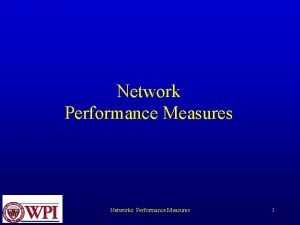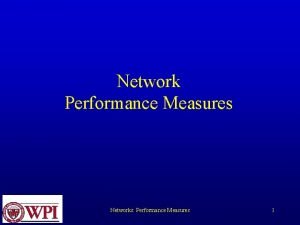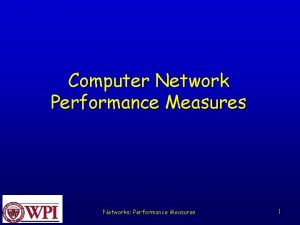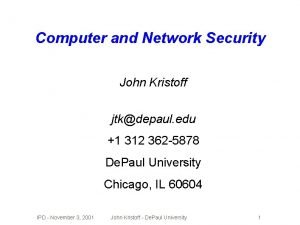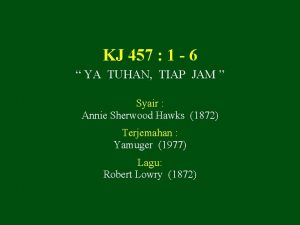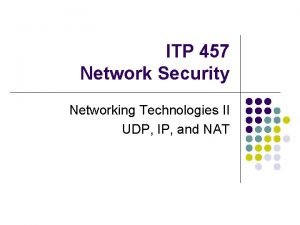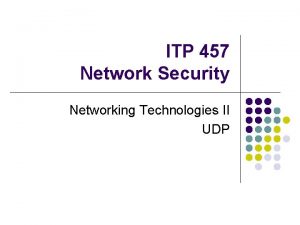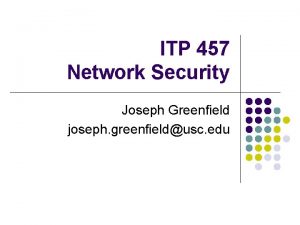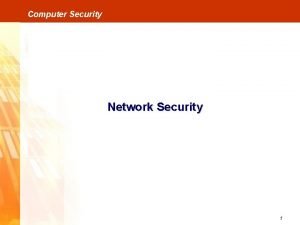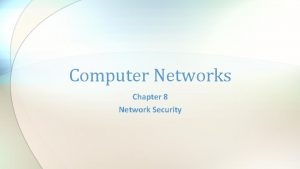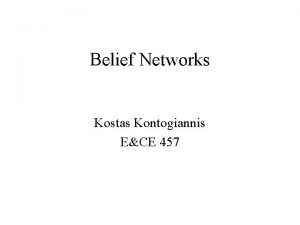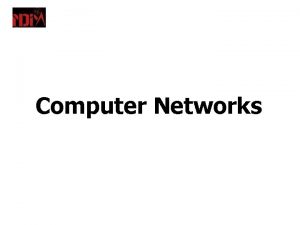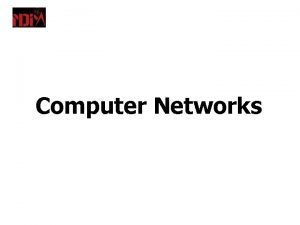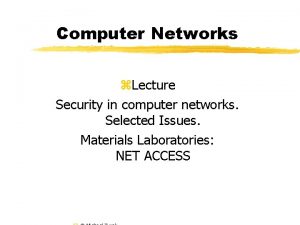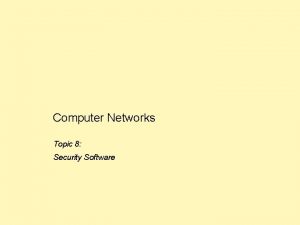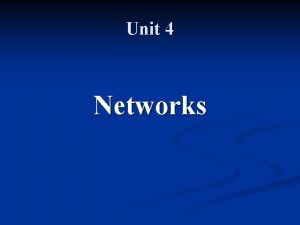ITP 457 Network Security Computer Networks Overview l



















- Slides: 19

ITP 457 Network Security Computer Networks

Overview l l l Brief Introduction to Computers and Computer Components What is a network? Introduction to Physical Networks LANs, WANs, and MANs Logical Network Topologies

Introduction to Computers l l Computers l Made up of hardware and software l Software cannot run by itself, and without software, your computer is an expensive paperweight Main Components l CPU (Central Processing Unit) – does the math that is necessary for computer use l Memory l l RAM (Random Access Memory) – temporary memory, very fast, not very big Secondary Storage – Hard Disks, Optical Media; large and slow Network Interface Cards – allow computers to communicate with one another Additional Add-In Cards include Sound, Video, SCSI, Firewire, etc.

Operating Systems l l Manages hardware and software so the user does not have to micro-manage Microsoft l Windows 95/98/ME l l Very limited networking capabilities Blue Screen of Death!!! Microsoft has completely abandoned this Operating System. We will not cover these OSes in this class Windows NT/2000/XP/2003 l l l Built on the NT kernel, which is a much more stable and network savvy kernel Security is an issue, due to holes in the O. S. We will cover these operating systems extensively

Unix l l Server-workstation operating system meant to be portable, multi-tasking, multi-user, & time sharing Originally written in the 70 s l l l Extremely popular, even today as Solaris 10 Was the primary reason that the programming language C grew to be the de-facto language We will not cover Unix in this class

Linux l l l Uses the Linux kernel, with a bunch of other stuff Its open-source, meaning its free to use and develop Most people download a distribution, which is a package of the Linux kernel with a bunch of other useful modules l You pay for documentation, proprietary modules, and support Is becoming very popular, due to the fact that it is free, reliable, and the linux community is very helpful in forums and IRC We will spend a few weeks on Linux, due to its popularity as a workstation and server operating system

Mac OS l l One of the first graphical user interfaces l Introduced in 1984 Original Mac OS (1984 – 2001) l Versions 6 – 9 l No command line; single tasking or very limited multitasking l Horrible memory management – user had to manually allocate memory OS X l Complete rewrite using the Mach Kernel and the Free BSD implementation of Unix l Has software emulation for older software l Now runs on Intel based processors We will not cover too much of Mac based security, but the same principles for Linux security can be applied to Macs.

Computer Networks l l Minimum: Two or more connected computers A good computer network consists of the following l l l l All hosts must use the same standard method for sending and receiving data Information must be delivered without any corruption There must be a way of acknowledging that the data has reached it’s destination Nodes must be able to determine the source of the communication The network should be scalable Nodes must be able to identify other nodes The network should run without the need for user micromanagement

Computer Network Components l Two main parts to the network l Physical Network l l l Physical connection between devices or nodes Hardware Wiring Wireless devices as well, but they are a little bit more complicated to understand Logical Network l l l Lays out the roles and routes for data transmission Dependent on the Protocol used for networking Software

Physical Network l l l Wires, cables, printers, hubs, switches, computers, servers, etc. Computers use Network Interface Cards (NICs) to interact with the network Network Topology l l Physical layout of components on the network Star, Ring, and Bus are the most common topologies l Mesh is becoming more prevalent, especially with wireless

Bus Topology l A long line with computers connected l l Components on the computer motherboard are connected using a bus 10 Base 2, 10 Base 5 use bus topologies Advantages: l l Called “taps” in the line Simple Cheap Quick Set-up Disadvantages: l l l Difficult to troubleshoot One break in the line causes the whole network to go down!!! Performance is directly proportional to the number of nodes on the line Very low security – all computers on the line can see the data Collision!!! l l Two computers trying to send information at the same time Carrier Sense Multiple Access fixes this somewhat

Ring Topology l l Every node has two connections, to create a closed network Token Ring and FDDI (Fiber Distributed Data Interface) use Ring Topologies Advantages: l Additional nodes do not directly impact performance (with a good protocol) l No packet collision Disadvantages: l Slow – data must pass through multiple nodes to reach destination l Any node failure causes the ring to die l To add a node, you must shut down the network l All systems must be on for the ring to work properly l Complete dependence on one cable – no redunancy

Star Topology l l l The most common topology for home and business networks Nodes have a connection to a central hub The hub can be connected to other hubs to create intricate diagrams 10 Base. T, 100 Base. T Advantages: l Good performance – limits the number of nodes to travel through l Easy to set-up and expand l A non-centralized failure will not bring down the network Disadvantages: l Most expensive topology – requires the most cabling and most hardware

Mesh Topology l l l Think of a combination of a star and ring topology Multiple ways for data to travel from source to destination Wireless Ad-Hoc networks are mesh networks l Wireless infrastructure (wireless access points and routers), are more of a star topology Advantages: l Extremely reliable & self healing l Easily scalable Disadvantages: l You never know exactly how the data is going to travel l The data may not flow in the most optimized manner l l In order to find the most optimal route, all routes must be tested Virus propagation is a HUGE issue

Network Sizes l l Completely arbitrary – no set definition of each LAN – Local Area Network l l WAN – Wide Area Network l l l Geographically separated LANs connected with routers and high-speed interconnections Typically connected with telephone, T 1 or T 3 lines, or Cable/DSL lines MAN – Metropolitan Area Network l l All computers are networked together Only occupies one “site” Typically high speed (100 Mbits/sec or 1 Gbit/sec) Larger number of WAN or LANs connected typically using wireless or fiber lines Internet l Either a WAN or a MAN, depending on how you define it

Logical Topology l l While the physical topology defines how the nodes are connected, the logical topology defines how the data is to be sent and how the network behaves from a software standpoint Ethernet Token Ring FDDI

Ethernet l l Most common logical topology Logical common bus topology Single bus to which all communication occurs Uses CSMA/CD – Carrier Sense Multiple Access/Collision Detection l l All computers share a single network segment Every computer listens on the network segment If no other computer is transmitting at that time, then the computer can transmit data If two computers send data at the same time, then a collision occurs. Both computers sense the conflict, and stop sending. They wait a “random” amount of time (in nanoseconds), then retransmits the data.

Ethernet Continued l Is classified as IEEE 802. 3 & 802. 3 u l l l 10 BASE-2: coaxial networking – dead 10 BASE-5: thicknet – dead 10 BASE-T: 2 of 4 pairs of unshielded twisted pair wire called CAT 5 cabling; speed of up to 10 Mbits/sec; dead 100 BASE-TX: fast ethernet; 2 of 4 pairs of unshielded twisted pair wire; speed of up to 100 Mbits/sec; seen everywhere 100 BASE-FX and 100 BASE-FL – fast ethernet on optical fibers; speed of up to 100 Mbits/sec; more expensive than 100 BASE-T; not used a whole lot anymore 1000 BASE-T: uses all 4 pairs of CAT 5 e or CAT 6 cabling; speed of up to 1000 Mbits/sec

Token Ring l l l Problem with CSMA/CD: Lots of computers on a network segment can cause starvation – computer may never get to transmit data IEEE 802. 5 – Token Ring l A special packet called a Token packet is passed around the ring l A computer can only transmit data when the computer has the token l When the computer is done transmitting, it releases the token FDDI – Fiber-Distributed Data Interface l Uses fiber optic lines instead of a copper wire l Can support thousands of users l Speed of up to 100 Mbits/sec l Has backup-ring in case of primary ring failure l Gigabit ethernet has made FDDI obsolete
 Datagram networks
Datagram networks Basestore iptv
Basestore iptv Palo alto networks certified network security consultant
Palo alto networks certified network security consultant Principles of network applications in computer networks
Principles of network applications in computer networks Network layer design issues in computer networks
Network layer design issues in computer networks Network layer design issues in computer networks
Network layer design issues in computer networks Network performance measurement in computer networks
Network performance measurement in computer networks Network performance measurement in computer networks
Network performance measurement in computer networks Network performance measurement in computer networks
Network performance measurement in computer networks Private secruity
Private secruity Osi security model
Osi security model Security guide to network security fundamentals
Security guide to network security fundamentals Wireless security in cryptography and network security
Wireless security in cryptography and network security Electronic mail security in network security
Electronic mail security in network security Security guide to network security fundamentals
Security guide to network security fundamentals Security guide to network security fundamentals
Security guide to network security fundamentals Computer & network security
Computer & network security Computer and network security
Computer and network security 888-457-5851
888-457-5851 457 1
457 1






